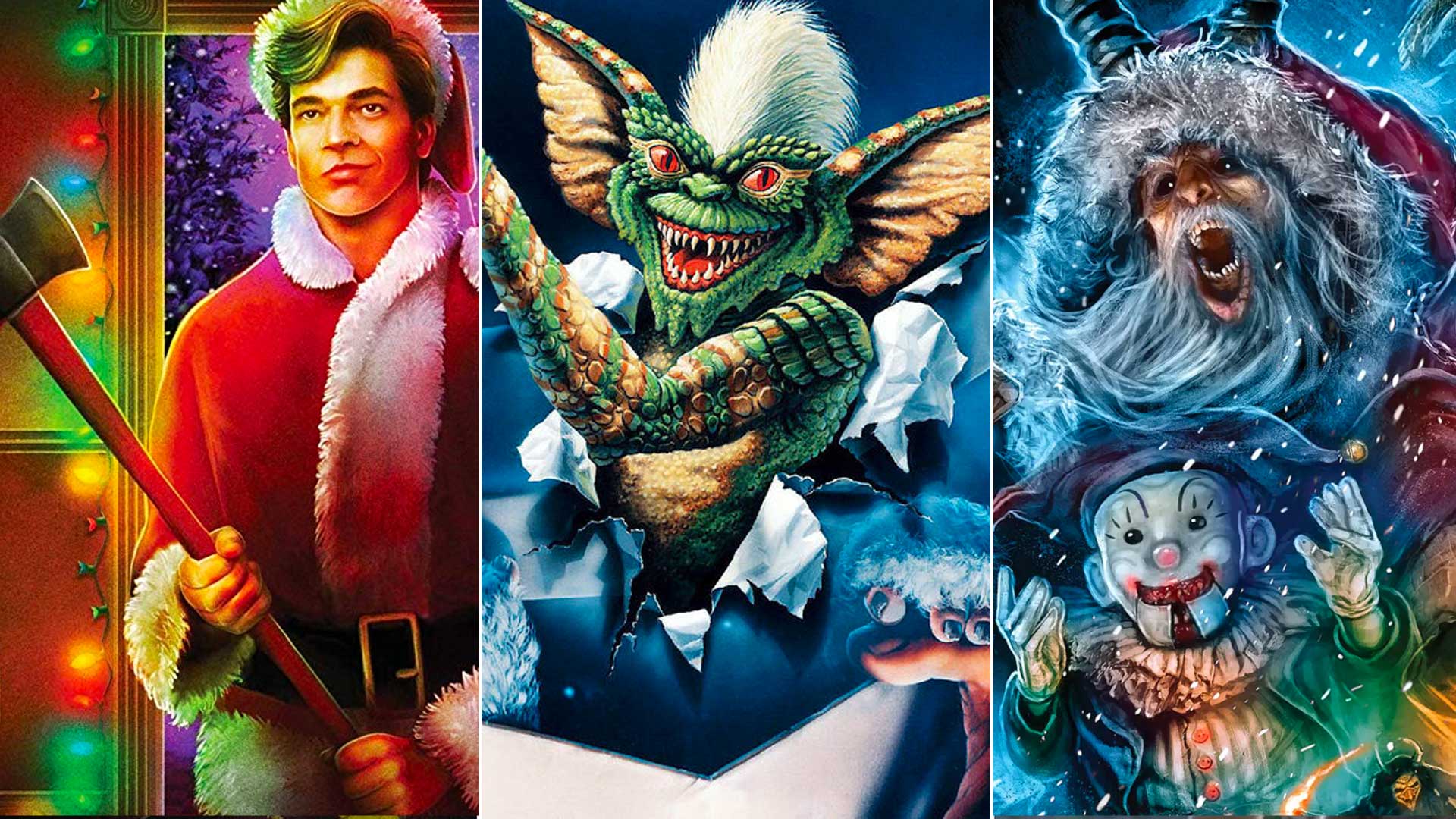Ever since Charles Dickens wrote about a ghostly trio peer-pressuring a pensioner into philanthropy, horror and Christmas have been the oddest of generation-spanning bedfellows. Countless festive ghost stories were written during the 19th and 20th centuries, then the tradition translated to the realm of film. Granted, Christmas horror flicks are often cash-grab B-movies, but we’ve fumbled through the best (and the best of the worst) to find you the essential picks of cinema’s spooky stocking stuffers.

The Curse Of The Cat People (1944)
1942’s Cat People was a genius psychological horror. Produced by the king of Golden Age Hollywood’s B thrillers, Val Lewton, it told the story of a woman paranoid that she’s cursed to become a murderous panther at night – whether or not it’s actually true. It also had the first true jump scare in cinema history.
Ghost story sequel The Curse Of The Cat People was lambasted by critics upon release, but has matured into a cult classic. Master filmmaker Robert Wise makes his directorial debut, which follows the original protagonist’s step-daughter as she too starts behaving erratically. With a climax set at Christmas, this is an underrated, enigmatic and well-acted follow-up eagerly awaiting discovery.
Tales From The Crypt (1972)
When most people hear about Tales From The Crypt, their mind jumps to the '90s series hosted by a pun-spewing puppet. However, the first onscreen adaptation of the anthology comics hit British cinemas in 1972, starring such legends as Peter Cushing and Joan Collins. And the first of its five segments takes place at Christmas.
Titled …And All Through The House, these ten minutes are endearing Hammer Horror-style silliness. A woman, played by Collins, murders her husband on Christmas Eve, only to see a serial killer outside her home – and she can’t call the police without exposing her own crime. Suspenseful and soundtracked solely by carols, this is a charming little Christmas chiller.
Black Christmas (1974)
Jointly inspired by real-life murders and that “the call was coming from inside the house” urban myth, future Christmas Story director Bob Clark made arguably the first true slasher film in 1974. Yes, Black Christmas codified the genre four years before Halloween, featuring a faceless killer that stockpiles teenagers’ corpses before a hauntingly ambiguous ending.
Even if its traits didn’t catch on, Black Christmas would still be a masterpiece. Clark cultivates a quiet intensity, with the terror coming from not the body count, but the anticipation between each kill. Plus, unlike in other holiday season horrors, the Christmas setting is no gimmick, since the paranoia subverts the warmth and safety so many feel at home in winter.
Gremlins (1984)
What is Gremlins? Is it a Christmas film? A black comedy? A teen drama? Or is it a horror? The answer to all of those questions is yes.
This edgy classic about knee-high monsters terrorising the suburbs is the result of everybody doing their jobs flawlessly. The screenplay, penned by future Home Alone and Harry Potter director Chris Columbus, juggles genres while maintaining a morbid yet mischievous tone. Joe Dante’s direction makes every visual gag land, and the practical effects are all effortlessly believable. With Steven Spielberg’s executive producer credit attached, Gremlins unsurprisingly dominated the box office and inspired a host of imitators that, in their shittiness, only affirmed how ingenious this film is.
Silent Night, Deadly Night Part 2 (1987)
If you’re a connoisseur of the camp, then Christmas is just an excuse to put on Silent Night, Deadly Night Part 2. This slasher sequel outdoes the sins of its trashy exploitation predecessor by being illiterate on how films even work. Almost half of it is archive footage from the original, and the new shots are crammed with the crumbiest of writing and performances.
However, therein lies the beauty. Lead actor Eric Freeman is gloriously batshit as Ricky Chapman, who hurls wild insults at a psychiatrist between flashbacks to his ridiculous killing spree. It’s never a garbage day when you get to laugh along to this unintentional comedy.
The Woman In Black (1989)
By itself, The Woman In Black is not a festive film. Herbert Wise’s TV movie even abandons the Christmastime opening of the Susan Hill novel (despite going on to become a truer adaptation than the more famous 2012 attempt with Daniel Radcliffe), before retelling the tale of solicitor Arthur Kipps’ ghostly encounters in Eel Marsh House. Then it ends with one of the freakiest jumps ever put to celluloid.
However, the film premiered on primetime ITV on Christmas Eve 1989, meaning that that closing scare kept every child awake and shaking long into the next morning. Also, the main character and his whole family die right before the credits roll. Merry fucking Christmas, everyone.
The Day Of The Beast (1995)
A horror comedy as black as coal, The Day Of The Beast follows a priest, a metalhead and a TV host as they try to prevent the birth of the antichrist on Christmas Eve. The trio’s quest forces them to steal a virgin’s blood, push mimes down staircases and rough up a street gang. But don’t worry, it’s God’s work.
Spanish auteur Álex De La Iglesia directed and co-wrote this wickedly funny unsung gem, which could well be the most metal Christmas film ever made. Álex Angulo’s lead turn as the priest is so deadly serious that it lapses into hilarity, while the narrative only grows more and more farcical as it goes.
Santa’s Slay (2005)
This bauble on the so-bad-it’s-brilliant tree comes from director David Steiman, who seemingly saw Bill Goldberg power-slamming people out of their shoes during WWE shows and thought, “That man should be Santa Claus.” However, the 6’4” muscle man doesn’t play Jolly Old Saint Nick; Santa’s Slay instead casts him as a demon that murders en masse every year.
Ultimately, the film’s as schlocky a slasher as the premise suggests, down to “jokes” that range from unfunny to offensive and a nonsensical narrative only in place to justify all the murder. That said, the kills are bloody great. Turkey leg impalement, reindeer trampling, Santa raining presents as bombs – every Christmassy death you’ve never imagined is here.
Inside (2007)
Inside is not the gateway to a happy Christmas. The directorial debut by horror tag team Julien Maury and Alexandre Bustillo (who would later make 2017’s Leatherface) is a cornerstone of the New French Extremity movement: a late-2000s wave of filmmaking that emphasised transgression and nihilism.
Inside is depressing enough to fit the genre from the off, as it shows a car crash that kills an expectant father and wounds a pregnant mother from the foetus’ perspective. From there, it’s a bleak, gore-laden and unbearably tense thriller about a woman trying to steal said mother’s baby on Christmas Eve, the day before it’s born. Misery from the first frame to the last.
Krampus (2015)
Krampus was a landmark moment in festive fright. It was America’s first big-budget Christmas horror since Gremlins and, despite eliciting many a “Humbug!” from critics, recouped more than four times the production's original budget.
Today, a longtime Netflix residency’s affirmed Krampus as a modern classic, and rightfully so. Michael Dougherty’s second seasonal horror (after 2007’s Halloween-obsessed Trick ’R Treat) balances jolts and laughs with a genuinely wholesome moral. The creature designs, especially that jack-in-a-box worm thing, are endearingly creative, while future Hereditary star Toni Collette acts her arse off despite all the silliness surrounding her. That ending’s still got people guessing, too.
- Best TV and film streaming services: What’s the best bang for your buck?

